Publications: Cliff B Jones - Computing Science - Newcastle University
Publications: Cliff B Jones - Computing Science - Newcastle University
Publications: Cliff B Jones - Computing Science - Newcastle University
You also want an ePaper? Increase the reach of your titles
YUMPU automatically turns print PDFs into web optimized ePapers that Google loves.
Main <strong>Publications</strong>: <strong>Cliff</strong> B <strong>Jones</strong>Books [1]–[11] (listing most recent first)Conference proceedings [12]–[24]Articles [25]–[153]Conference talks (where no publication cited) [154].–[185]Technical reports 1 (where not preprints of articles) [186]–[235] 2References[1] D. Besnard, C. Gacek, and C. B. <strong>Jones</strong>, editors. Structure for Dependability:Computer-Based Systems from an Interdisciplinary Perspective. Springer, 2006.[2] C. B. <strong>Jones</strong>, K. D. <strong>Jones</strong>, P. A. Lindsay, and R. Moore. mural: A Formal DevelopmentSupport System. Springer-Verlag, 1991.[3] C. B. <strong>Jones</strong>. Systematic Software Development using VDM. Prentice Hall International,second edition, 1990.[4] C. B. <strong>Jones</strong> and R. C. F. Shaw, editors. Case Studies in Systematic SoftwareDevelopment. Prentice Hall International, 1990.[5] C. A. R. Hoare and C. B. <strong>Jones</strong>. Essays in <strong>Computing</strong> <strong>Science</strong>. Prentice HallInternational, 1989.[6] C. B. <strong>Jones</strong>. Systematic Software Development Using VDM. Prentice Hall International,1986.[7] H. Bekič and C. B. <strong>Jones</strong>, editors. Programming Languages and Their Definition:Selected Papers of H. Bekič, volume 177 of Lecture Notes in Computer<strong>Science</strong>. Springer-Verlag, 1984.[8] Dines Bjørner and <strong>Cliff</strong> B. <strong>Jones</strong>, editors. Formal Specification and SoftwareDevelopment. Prentice Hall International, 1982.[9] C. B. <strong>Jones</strong>. Software Development: A Rigorous Approach. Prentice Hall International,1980.[10] D. Bjørner and C. B. <strong>Jones</strong>, editors. The Vienna Development Method: TheMeta-Language, volume 61 of Lecture Notes in Computer <strong>Science</strong>. Springer-Verlag, 1978.1 In industry, even significant items were not necessarily published externally: e.g. [217] was a completedefintion of ALGOL 60 using “functional semantics”; [209] introduced the concept of “implementationbias”; [222] introduced the “exit” idea; and [213] was the key output of the denotational semanticsdefinition of PL/I (which marks the start of VDM as a language defintion method).2 [208] is my D.Phil. Thesis.1
[11] K. V. Hanford and C. B. <strong>Jones</strong>. Dynamic Syntax: A Concept for the Definitionof the Syntax of Programming Languages, volume 7 of Annual Review inAutomatic Programming. Pergamon Press, 1974.[12] <strong>Cliff</strong> <strong>Jones</strong> and Bill Roscoe, editors. Reflections on the work of C.A.R.Hoare.Springer, 2010.[13] <strong>Cliff</strong> B. <strong>Jones</strong>, Zhiming Liu, and Jim Woodcock, editors. Formal Methodsand Hybrid Real-Time Systems: Essays in Honour of Dines Bjørner and ZhouChaochen on the Occasion of Their 70th Birthdays, volume 4700 of LectureNotes in Computer <strong>Science</strong>. Springer, 2007.[14] <strong>Cliff</strong> B. <strong>Jones</strong>, Zhiming Liu, and Jim Woodcock, editors. Theoretical Aspectsof <strong>Computing</strong> – ICTAC 2007. Number 4711 in Lecture Notes in Computer<strong>Science</strong>. Springer, 2007.[15] Michael Butler, <strong>Cliff</strong> <strong>Jones</strong>, Alexander Romanovsky, and Elena Troubitsyna,editors. Methods, Models and Tools for Fault-Tolerance, volume 5454 of LectureNotes in Computer <strong>Science</strong>. Springer, 2009.[16] M. Butler, C. <strong>Jones</strong>, A. Romanovsky, and E. Troubitsyna, editors. RigorousDevelopment of Complex Fault-Tolerant Systems, volume 4157 of Lecture Notesin Computer <strong>Science</strong>. Springer, 2006.[17] M. Butler, C. B. <strong>Jones</strong>, A. Romanovsky, and E. Troubitsyna. Proceedings ofthe workshop on rigorous engineering of fault-tolerant systems (REFT 2005).Technical Report CS-TR-915, ISSN 1368-1060, School of <strong>Computing</strong> <strong>Science</strong>,<strong>University</strong> of <strong>Newcastle</strong>, April 2005.[18] Ali E. Abdallah, <strong>Cliff</strong> B. <strong>Jones</strong>, and Jeff W. Sanders, editors. CommunicatingSequential Processes: the First 25 years, volume 3525 of Lecture Notes inComputer <strong>Science</strong>. Springer, 2005.[19] John Dobson, <strong>Cliff</strong> <strong>Jones</strong>, Rob Procter, Mark Rouncefiled, and Robin Williams,editors. Interdisciplinary approaches to the design of dependable computer systems.ACM, Proceedings of the 2002 ACM symposium on Applied <strong>Computing</strong>,Madrid, 2002.[20] John Fitzgerald, <strong>Cliff</strong> B. <strong>Jones</strong>, and Peter Lucas, editors. FME’97: IndustrialApplications and Strengthened Foundations of Formal Methods, volume 1313of Lecture Notes in Computer <strong>Science</strong>. Springer-Verlag, 1997.[21] Burkhard Freitag, <strong>Cliff</strong> B. <strong>Jones</strong>, Christian Lengauer, and Hans-Jörg Schek,editors. Object Orientation with Parallelism and Persistence. Kluwer AcademicPublishers, 1996.[22] C. B. <strong>Jones</strong>, R. C. Shaw, and T. Denvir, editors. 5th Refinement Workshop.Springer-Verlag, 1992.[23] M. Broy and C. B. <strong>Jones</strong>, editors. Programming Concepts and Methods. North-Holland, 1990.2
[24] D. Bjørner, C. B. <strong>Jones</strong>, M. Mac an Airchinnigh, and E. J. Neuhold, editors.VDM – A Formal Definition at Work, volume 252 of Lecture Notes in Computer<strong>Science</strong>. Springer-Verlag, 1987.[25] <strong>Cliff</strong> B. <strong>Jones</strong>. The role of auxiliary variables in the formal development ofconcurrent programs. In <strong>Cliff</strong> <strong>Jones</strong> and Bill Roscoe, editors, Reflections on thework of C. A. R. Hoare, page in press. Springer, 2010.[26] Alan Bundy, Gudmund Grov, and <strong>Cliff</strong> B. <strong>Jones</strong>. An outline of a proposed systemthat learns from experts how to discharge proof obligations automatically.In Jean-Raymond Abrial, Michael Butler, Rajeev Joshi, Elena Troubitsyna, andJim C. P. Woodcock, editors, Dagstuhl 09381: Refinement Based Methods forthe Construction of Dependable Systems, pages 38–42, 2009.[27] <strong>Cliff</strong> B. <strong>Jones</strong>. Abstraction is all we’ve got: auxiliary variables considered harmful.In Jean-Raymond Abrial, Michael Butler, Rajeev Joshi, Elena Troubitsyna,and Jim C. P. Woodcock, editors, Dagstuhl 09381: Refinement Based Methodsfor the Construction of Dependable Systems, pages 94–98, 2009.[28] <strong>Cliff</strong> B. <strong>Jones</strong>. From problem frames to HJJ: known unknowns. In BasharNuseibeh and Pamela Zave, editors, Festschrift for Michael Jackson, page inpress. Lulu, 2010.[29] Alan Bundy, Gudmund Grov, and <strong>Cliff</strong> B. <strong>Jones</strong>. Learning from experts to aidthe automation of proof search. In Liam O’Reilly and Markus Roggenbach,editors, AVoCS’09 – PreProceedings of the Ninth International Workshop onAutomated Verification of Critical Systems, Technical Report of Computer <strong>Science</strong>CSR-2-2009, pages 229–232. Swansea <strong>University</strong>, 2009.[30] J. S. Fitzgerald and C. B. <strong>Jones</strong>. The connection between two ways of reasoningabout partial functions. IPL, 107(3–4):128–132, 2008.[31] J. S. Fitzgerald, J. W. Bryans, D. Greathead, C. B. <strong>Jones</strong>, and R. Payne.Animation-based validation of a formal model of dynamic vitual organisations.In P. Boca, J. Bowen, and P.G. Larsen, editors, FACS 2007 Christmas Workshop:Formal Methods in Industry, BCS London, UK, December 2008. BCS.[32] <strong>Cliff</strong> B. <strong>Jones</strong>. Some interdisciplinary observations about getting the “right”specification. In B. Meyer and J. P. C. Woodcock, editors, Verified Software:Theories, Tools, Experiments, number 4171 in LNCS, pages 64–69. Springer,2008.[33] <strong>Cliff</strong> B. <strong>Jones</strong> and Ken G. Pierce. Splitting atoms with rely/guarantee conditionscoupled with data reification. In ABZ2008, volume LNCS 5238, pages 360–377,2008.[34] John R. D. Hughes and C. B. <strong>Jones</strong>. Reasoning about programs via operationalsemantics: Requirements for a support system. Automated Software Engineering,??, 2008.3
[35] <strong>Cliff</strong> B. <strong>Jones</strong>. Reflections on, and predictions for, support systems for thedevelopment of programs. Proceedings ASE-08, 2008.[36] <strong>Cliff</strong> B. <strong>Jones</strong>, Ian J. Hayes, and Michael A. Jackson. Deriving specificationsfor systems that are connected to the physical world. In <strong>Cliff</strong> B. <strong>Jones</strong>, ZhimingLiu, and Jim Woodcock, editors, Formal Methods and Hybrid Real-Time Systems:Essays in Honour of Dines Bjørner and Zhou Chaochen on the Occasionof Their 70th Birthdays, volume 4700 of Lecture Notes in Computer <strong>Science</strong>,pages 364–390. Springer Verlag, 2007.[37] <strong>Cliff</strong> B. <strong>Jones</strong>. Understanding programming language concepts via operationalsemantics. In Chris George, Zhiming Liu, and Jim Woodcock, editors, DomainModeling and the Duration Calculus, volume 4710 of Lecture Notes in Computer<strong>Science</strong>, pages 177–235. Springer, 2007.[38] <strong>Cliff</strong> <strong>Jones</strong>. Discussion of the ideal of program correctness by Tony Hoare. TheComputer Journal, 50(3):261–262, 2007.[39] <strong>Cliff</strong> B. <strong>Jones</strong> and Ken G. Pierce. What can the π-calculus tell us about themondex purse system? In ICECCS ’07: Proceedings of the 12th IEEE InternationalConference on Engineering Complex Computer Systems (ICECCS 2007),pages 300–306. IEEE, IEEE Computer Society, 2007.[40] <strong>Cliff</strong> B. <strong>Jones</strong>. Vdm ”post-ludium”. In D. Bjørner and M. Henson, editors,Logics of Specification Languages, pages 614–616. Springer, 2007.[41] J. W. Coleman and C. B. <strong>Jones</strong>. A structural proof of the soundness ofrely/guarantee rules. Journal of Logic and Computation, 17(4):807–841, 2007.[42] C. B. <strong>Jones</strong>. Splitting atoms safely. Theoretical Computer <strong>Science</strong>, 357:109–119, 2007.[43] <strong>Cliff</strong> B. <strong>Jones</strong> and Brian Randell. The role of structure: a dependability perspective.In D. Besnard, C. Gacek, and C. B. <strong>Jones</strong>, editors, Structure for Dependability:Computer-Based Systems from an Interdisciplinary Perspective,chapter 1, pages 3–15. Springer, 2006.[44] <strong>Cliff</strong> B. <strong>Jones</strong>. The DIRC project. In Trust in Technology: a Socio-TechnicalPerspective, chapter 10, pages 217–221. Springer, 2006.[45] <strong>Cliff</strong> <strong>Jones</strong>, Peter O’Hearn, and Jim Woodcock. Verified software: a grandchallenge. IEEE Computer, 39(4):93–95, 2006.[46] <strong>Cliff</strong> B. <strong>Jones</strong>. Reasoning about partial functions in the formal developmentof programs. In Proceedings of AVoCS’05, volume 145, pages 3–25. Elsevier,Electronic Notes in Theoretical Computer <strong>Science</strong>, 2006.[47] T. P. Clement and C. B. <strong>Jones</strong>. Model-oriented specifications. FACS FACTS,2006-2:39–53, 2006.[48] C. B. <strong>Jones</strong>, D. Lomet, A. Romanovsky, and G. Weikum. The atomic manifesto:a story in four quarks. ACM SIGMOD Record, 34(1):63–69, 2005.4
[49] <strong>Cliff</strong> B. <strong>Jones</strong>. Specification before satisfaction: the case for research into obtainingthe right specification. In Helen Treharne, Steve King, Martin Henson,and Steve Schneider, editors, ZB-2005, volume 3455 of Lecture Notes in Computer<strong>Science</strong>, pages 1–5. Springer Verlag, 2005.[50] D. Greathead and C. B. <strong>Jones</strong>. DIRC: an interdisciplinary attack on problemsof dependability. In EDCC-5, Budapest, Supplementary Volume, pages 11–14,April 2005.[51] Joey Coleman, <strong>Cliff</strong> <strong>Jones</strong>, Ian Oliver, Alexander Romanovsky, and ElenaTroubitsyna. RODIN (rigorous open development environment for complexsystems). In EDCC-5, Budapest, Supplementary Volume, pages 23–26, April2005.[52] C. B. <strong>Jones</strong>. Sequencing operations and creating objects. In Proceedings TenthIEEE International Conference on Engineering of Complex Computer Systems,pages 33–36. IEEE Computer Society, 2005.[53] C. B. <strong>Jones</strong>, D. Lomet, A. Romanovsky, and G. Weikum. The atomic manifesto.Journal of Universal Computer <strong>Science</strong>, 11(5):636–650, 2005.[54] J. I. Burton and C. B. <strong>Jones</strong>. Atomicity in system design and execution. Journalof Universal Computer <strong>Science</strong>, 11(5):634–635, 2005.[55] J. I. Burton and C. B. <strong>Jones</strong>. Investigating atomicity and observability. Journalof Universal Computer <strong>Science</strong>, 11(5):661–686, 2005.[56] Joey W. Coleman and <strong>Cliff</strong> B. <strong>Jones</strong>. Examples of how to determine the specificationsof control systems. In M. Butler, C. <strong>Jones</strong>, A. Romanovsky, andE. Troubitsyna, editors, Proceedings of the Workshop on Rigorous Engineeringof Fault-Tolerant Systems (REFT 2005), number CS-TR-915 in TechnicalReport Series, pages 65–73. <strong>University</strong> of <strong>Newcastle</strong> Upon Tyne, June 2005.see www.cs.ncl.ac.uk/research/pubs/trs/papers/915.pdf.[57] C. B. <strong>Jones</strong>. Reasoning about the design of programs. Royal Soc, Phil Trans RSoc A, 363(1835):2395–2396, 2005.[58] C. B. <strong>Jones</strong>. An approach to splitting atoms safely. Electronic Notes in TheoreticalComputer <strong>Science</strong>, MFPS XXI, 21st Annual Conference of MathematicalFoundations of Programming Semantics, 155:43–60, 2006.[59] Tony Hoare, <strong>Cliff</strong> <strong>Jones</strong>, and Brian Randell. Extending the horizons of DSE. InGrand Challenges. UKCRC, 2004.[60] <strong>Cliff</strong> <strong>Jones</strong> and Brian Randell. Dependable pervasive systems. In RobinMansell and Brian S. Collins, editors, Trust and Crime in Information Societies,chapter 3, pages 59–90. Edward Elgar, 2005. also visible athttp://www.foresight.gov.uk.[61] <strong>Cliff</strong> <strong>Jones</strong>, Panos Periorellis, Alexander Romanovsky, and Ian Welch. Structuredhandling of on-line interface upgrades in integrating dependable systems5
of systems. In N. Guelfi, E. Astesiano, and G. Reggio, editors, FIDGI 2002, volume2604 of Lecture Notes in Computer <strong>Science</strong>, pages 73–86. Springer Verlag,2003.[62] <strong>Cliff</strong> B <strong>Jones</strong>. A formal basis for some dependability notions. In Bernhard K.Aichernig and Tom Maibaum, editors, Formal Methods at the Crossroads: fromPanacea to Foundational Support, volume 2757 of Lecture Notes in Computer<strong>Science</strong>, pages 191–206. Springer Verlag, 2003.[63] <strong>Cliff</strong> B. <strong>Jones</strong>. The early search for tractable ways of reasonning about programs.IEEE, Annals of the History of <strong>Computing</strong>, 25(2):26–49, 2003.[64] <strong>Cliff</strong> B. <strong>Jones</strong>. Operational semantics: concepts and their expression. InformationProcessing Letters, 88(1-2):27–32, 2003.[65] Ian Hayes, Michael Jackson, and <strong>Cliff</strong> <strong>Jones</strong>. Determining the specification of acontrol system from that of its environment. In Keijiro Araki, Stefani Gnesi, andDino Mandrioli, editors, FME 2003: Formal Methods, volume 2805 of LectureNotes in Computer <strong>Science</strong>, pages 154–169. Springer Verlag, 2003.[66] C. B. <strong>Jones</strong>. Wanted: a compositional approach to concurrency. In AnnabelleMcIver and Carroll Morgan, editors, Programming Methodology, pages 1–15.Springer Verlag, 2003.[67] A. T. Lawrie and C. B. <strong>Jones</strong>. Goal-diversity in the design of dependablecomputer-based systems. In (in) Proceedings of the Open Source Software DevelopmentWorkshop, CS-TR-812, 2002.[68] <strong>Cliff</strong> <strong>Jones</strong>, Alexander Romanovsky, and Ian Welch. A structured approach tohandling on-line interface upgrades. In COMPSAC 2002, pages 1000–1005.IEEE, 2002.[69] C. B. <strong>Jones</strong>. The transition from VDL to VDM. Journal of Universal Computer<strong>Science</strong>, 7(8):631–640, 2001.[70] B. Randell, R. Stroud, and C. <strong>Jones</strong>. DSoS (Dependable Systems of Systems).In Proceedings of the 2001 International Conference on Dependable Systemsand Networks (DSN-2001), Gothenburg, Sweden, 1-4 July 2001, pages D28–D31. IEEE Computer Society Press, 2001.[71] Pierre Collette and <strong>Cliff</strong> B. <strong>Jones</strong>. Enhancing the tractability of rely/guaranteespecifications in the development of interfering operations. In Gordon Plotkin,Colin Stirling, and Mads Tofte, editors, Proof, Language and Interaction, chapter10, pages 277–307. MIT Press, 2000.[72] C. B. <strong>Jones</strong>. Compositionality, interference and concurrency. In Jim Davies,Bill Roscoe, and Jim Woodcock, editors, Milennial Perspectives in Computer<strong>Science</strong>, pages 175–186. Macmillian Press, 2000.[73] C. B. <strong>Jones</strong>. Thinking tools for the future of computing science. In ReinhardWilhelm, editor, Informatics – 10 Years Back, 10 Years forward, volume 2000of Lecture Notes in Computer <strong>Science</strong>, pages 112–130. Springer-Verlag, 2000.6
[74] C. B. <strong>Jones</strong>. Dependability of computer-based systems. In XIV SimposiaBrasiliero de Engenharia de Software, pages 16–20, 2000.[75] I. J. Hayes and C. B. <strong>Jones</strong>. Specifications are not (necessarily) executable.In High-Integrity System Specification and Design, FACIT, pages 563–581.Springer-Verlag, 1999.[76] C. B. <strong>Jones</strong>. Scientific decisions which characterize VDM. In FM’99 – FormalMethods, volume 1708 of Lecture Notes in Computer <strong>Science</strong>, pages 28–47.Springer-Verlag, 1999.[77] John Fitzgerald and <strong>Cliff</strong> <strong>Jones</strong>. A tracking system. In J. C. Bicarregui, editor,Proof in VDM: Case Studies, FACIT, pages 1–30. Springer-Verlag, 1998.[78] C. B. <strong>Jones</strong>. Some mistakes I have made and what I have learned from them.In Fundamental Approaches to Software Engineering, volume 1382 of LectureNotes in Computer <strong>Science</strong>, pages 7–20. Springer-Verlag, 1998.[79] C. B. <strong>Jones</strong>. Whither formal methods? a plea to investigate new applications. InMichael G Hinchey and Shaoying Liu, editors, Formal Engineering Methods,page 5. IEEE Computer Society, 1997.[80] C. B. <strong>Jones</strong>. Accommodating interference in the formal design of concurrentobject-based programs. Formal Methods in System Design, 8(2):105–122,March 1996.[81] Edmund M. Clarke, Jeannette M. Wing, <strong>Cliff</strong> B. <strong>Jones</strong>, et al. Formal methods:State of the art and future directions. ACM, <strong>Computing</strong> Surveys, 28(4):626–643,December 1996.[82] C. B. <strong>Jones</strong>. Some practical problems and their influence on semantics. InESOP’96, volume 1058 of Lecture Notes in Computer <strong>Science</strong>, pages 1–17.Springer-Verlag, 1996.[83] J. R. Gurd and C. B. <strong>Jones</strong>. The global-yet-personal information system. InIan Wand and Robin Milner, editors, <strong>Computing</strong> Tomorrow, pages 127–157.Cambridge <strong>University</strong> Press, 1996.[84] D. N. Jackson, C. B. <strong>Jones</strong>, and J. Wing. Formal methods light. IEEE, Computer,29(4):20–22, 1996.[85] C. B. <strong>Jones</strong>. TANSTAAFL (with partial functions). In William Farmer, ManfredKerber, and Michael Kohlhase, editors, Proceedings of the CADE-13 Workshopon the Mechanization Of Partial Functions, pages 53–64, 1996.[86] C. B. <strong>Jones</strong>. Describing the semantics of concurrent object-oriented languages.In William Farmer, Manfred Kerber, and Michael Kohlhase, editors, Proceedingsof the 3rd International Workshop on Foundations of Object-Oriented Languages(FOOL-3 with LICS’96, pages 24–25, 1996.7
[87] Steve J. Hodges and <strong>Cliff</strong> B. <strong>Jones</strong>. Non-interference properties of a concurrentobject-based language: Proofs based on an operational semantics. In BurkhardFreitag, <strong>Cliff</strong> B. <strong>Jones</strong>, Christian Lengauer, and Hans-Jörg Schek, editors, OjectOrientation with Parallelism and Persistence, pages 1–22. Kluwer AcademicPublishers, 1996.[88] C. B. <strong>Jones</strong>. Granularity and the development of concurrent programs. In ProceedingsMFPS’95, volume 1 of Electronic Notes in Theoretical Computer <strong>Science</strong>,pages 302–306. Elsevier, 1995.[89] C. B. <strong>Jones</strong>. Fixing the semantics of some concurrent object-oriented concepts.In Proceedings MFPS’95, volume 1 of Electronic Notes in Theoretical Computer<strong>Science</strong>, pages 307–312. Elsevier, 1995.[90] C.B. <strong>Jones</strong>. Partial functions and logics: A warning. Information ProcessingLetters, 54(2):65–67, 1995.[91] C. B. <strong>Jones</strong>. Process algebra arguments about an object-based design notation.In A. W. Roscoe, editor, A Classical Mind, chapter 14, pages 231–246. Prentice-Hall, 1994.[92] C.B. <strong>Jones</strong> and C.A. Middelburg. A typed logic of partial functions reconstructedclassically. Acta Informatica, 31(5):399–430, 1994.[93] C. B. <strong>Jones</strong>. Constraining interference in an object-based design method. InM-C. Gaudel and J-P. Jouannaud, editors, TAPSOFT’93: Theory and Practiceof Software Development, volume 668 of Lecture Notes in Computer <strong>Science</strong>,pages 136–150. Springer-Verlag, 1993.[94] C. B. <strong>Jones</strong>. Reasoning about interference in an object-based design method. InFME’93: Industrial-Strength Formal Methods, volume 670 of Lecture Notes inComputer <strong>Science</strong>, pages 1–18. Springer-Verlag, 1993.[95] I. J. Hayes, C. B. <strong>Jones</strong>, and J. E. Nicholls. Understanding the differencesbetween VDM and Z. ACM Software Engineering News, 19(3):75–81, July1994.[96] C. B. <strong>Jones</strong>. A pi-calculus semantics for an object-based design notation. InCONCUR’93: 4th International Conference on Concurrency Theory, volume715 of Lecture Notes in Computer <strong>Science</strong>, pages 158–172. Springer-Verlag,1993.[97] C. B. <strong>Jones</strong>. An object-based design method for concurrent programs. In S. Meldaland M. Haveraaen, editors, 4th Nordic Workshop on Program Correctness,pages 27–52. <strong>University</strong> of Bergen, 1993. Report No. 78, ISSN 0333-3590.[98] J. H. Cheng and C. B. <strong>Jones</strong>. On the usability of logics which handle partialfunctions. In C. Morgan and J. C. P. Woodcock, editors, 3rd Refinement Workshop,pages 51–69. Springer-Verlag, 1991.[99] C. B. <strong>Jones</strong>. Interference revisited. In J. E. Nicholls, editor, Z User Workshop,pages 58–73. Springer-Verlag, 1991.8
[100] C. B. <strong>Jones</strong>. Does the O-O community need formal methods? In J. Bézivin andB. Meyer, editors, TOOLS 4: Technology of Object-Oriented Languages andSystems, pages 15–22. Prentice-Hall, 1991.[101] C. B. <strong>Jones</strong>. Can computer programs be trusted? In Nigel Calder, editor,Scientific Euorope, pages 304–309. Foundation Scientific Europe, 1991.[102] C. B. <strong>Jones</strong>. Interference resumed. In P. Bailes, editor, Engineering Safe Software,pages 31–56. Australian Computer Society, 1991.[103] C. B. <strong>Jones</strong>. A small language definition. In <strong>Jones</strong> and Shaw [4], chapter 9,pages 235–256.[104] J.S. Fitzgerald and C. B. <strong>Jones</strong>. Modularizing the formal description of adatabase system. In D. Bjørner, C. A. R. Hoare, and H. Langmaack, editors,VDM’90: VDM and Z – Formal Methods in Software Development, volume428 of Lecture Notes in Computer <strong>Science</strong>, pages 189–210. Springer-Verlag,1990.[105] C. B. <strong>Jones</strong>. Consequences. In Beauty is Our Business, chapter 25. Springer-Verlag, 1990.[106] C. B. <strong>Jones</strong>. Data reification. In J. A. McDermid, editor, The Theory andPractice of Refinement, pages 79–89. Butterworths, 1989.[107] I. J. Hayes and C. B. <strong>Jones</strong>. Specifications are not (necessarily) executable. IEE,Software Engineering Journal, 4(6):320–338, November 1989.[108] C. B. <strong>Jones</strong> and P. A. Lindsay. A support system for formal reasoning: Requirementsand status. In R. Bloomfield, L. Marshall, and R. <strong>Jones</strong>, editors,VDM’88: VDM – The Way Ahead, volume 328 of Lecture Notes in Computer<strong>Science</strong>, pages 139–152. Springer-Verlag, 1988.[109] C. B. <strong>Jones</strong> and R. Moore. Muffin: A user interface design experiment for atheorem proving assistant. In R. Bloomfield, L. Marshall, and R. <strong>Jones</strong>, editors,VDM’88: VDM – The Way Ahead, volume 328 of Lecture Notes in Computer<strong>Science</strong>, pages 337–375. Springer-Verlag, 1988.[110] C. B. <strong>Jones</strong>. Theorem proving and software engineering. IEE, Software EngineeringJournal, 3(1):2, 1988.[111] C. B. <strong>Jones</strong>. VDM proof obligations and their justification. In Bjørner et al.[24], pages 260–286.[112] C. B. <strong>Jones</strong>. Program specification and verification in VDM. In M. Broy, editor,Logic of Programming and Calculi of Discrete Design, volume 36 of NATOASI Series F: Computer and Systems <strong>Science</strong>s, pages 149–184. Springer-Verlag,1987.[113] C. B. <strong>Jones</strong>. Software development based on formal methods. In A. N. Habermannand U. Montanari, editors, System Development and Ada, volume 275 ofLecture Notes in Computer <strong>Science</strong>, pages 153–172. Springer-Verlag, 1987.9
[114] C. B. <strong>Jones</strong>. Proof obligations for data reification. In O. G. Folberth andC. Hackl, editors, Der Informationsbegriff in Technik und Wissenschaft, pages77–96. Oldenbourg Verlag, 1986. Festschrift–Prof. Karl E. Ganzhorn.[115] C. B. <strong>Jones</strong>. Systematic program development. In J. W. de Bakker,M. Hazewinkel, and J. K. Lenstra, editors, Mathematics and Computer <strong>Science</strong>,pages 19–50. North-Holland, 1986.[116] C. B. <strong>Jones</strong>. Specifications and programs. In WspółCzesne Kierunki RozwojuInformtyki, pages 33–48, 1986.[117] C. B. <strong>Jones</strong>. Specyfikacje a programy I. Informatyka, 10:1–4, 1987.[118] C. B. <strong>Jones</strong>. Specyfikacje a programy II. Informatyka, 11:2–6, 1987.[119] C. B. <strong>Jones</strong>. The role of proof obligations in software design. In Formal Methodsand Software Development, volume 186 of Lecture Notes in Computer <strong>Science</strong>,pages 27–41. Springer-Verlag, 1985.[120] I. D. Cottam, C. B. <strong>Jones</strong>, T. Nipkow, A. C. Wills, M. I. Wolczko, and A. Yaghi.Project support environments for formal methods. In J. McDermid, editor, IntegratedProject Support Environments, chapter 3. Peter Peregrinus Ltd., 1985.[121] C. B. <strong>Jones</strong>. Systematic program development. In N. Gehani and A. D. McGettrick,editors, Software Specification Techniques, pages 89–110. Addison-Wesley, 1985. revised version of [115].[122] C. B. <strong>Jones</strong>. Specification, verification and testing in software development.In T. Anderson, editor, Software Requirements Specification and Testing, pages1–13. Blackwell Scientific <strong>Publications</strong>, 1985.[123] F. L. Morris and C. B. <strong>Jones</strong>. An early program proof by Alan Turing. Annalsof the History of <strong>Computing</strong>, 6(2):139–143, 1984.[124] H. Barringer, J.H. Cheng, and C. B. <strong>Jones</strong>. A logic covering undefinedness inprogram proofs. Acta Informatica, 21:251–269, 1984.[125] C. B. <strong>Jones</strong>. Specification and verification. IEEE, Transactions of SoftwareEngineering, SE-10:126–127, 1984.[126] C. B. <strong>Jones</strong>. Specification and design of (parallel) programs. In Proceedings ofIFIP’83, pages 321–332. North-Holland, 1983.[127] C. B. <strong>Jones</strong>. Tentative steps toward a development method for interfering programs.Transactions on Programming Languages and System, 5(4):596–619,1983.[128] <strong>Cliff</strong> B. <strong>Jones</strong>. The meta-language. In Bjørner and <strong>Jones</strong> [8], chapter 2, pages25–46.[129] <strong>Cliff</strong> B. <strong>Jones</strong>. Modelling concepts of programming languages. In Bjørner and<strong>Jones</strong> [8], chapter 4, pages 85–124.10
[130] <strong>Cliff</strong> B. <strong>Jones</strong>. More on exception mechanisms. In Bjørner and <strong>Jones</strong> [8],chapter 5, pages 125–140.[131] Wolfgang Henhapl and <strong>Cliff</strong> B. <strong>Jones</strong>. Algol 60. In Bjørner and <strong>Jones</strong> [8],chapter 6, pages 141–174.[132] <strong>Cliff</strong> B. <strong>Jones</strong>. Compiler design. In Bjørner and <strong>Jones</strong> [8], chapter 8, pages253–270.[133] Elizabeth Fielding and <strong>Cliff</strong> B. <strong>Jones</strong>. The meta-language. In Bjørner and <strong>Jones</strong>[8], chapter 10, pages 323–352.[134] C. B. <strong>Jones</strong>. Formal methods in software development. In Proceedings of Stateof the Art Review 1981, pages 107–113. Infotech, 1981.[135] C. B. <strong>Jones</strong>. Towards more formal specifications. In C. Floyd and H. Kopetz,editors, Software Engineering – Entwurf und Specifikation, pages 19–45. TeubnerVerlag, 1981.[136] C. B. <strong>Jones</strong>. Specification as a design base. In Trends in Information Processing,volume 123 of Lecture Notes in Computer <strong>Science</strong>, pages 103–105. Springer-Verlag, 1981.[137] C. B. <strong>Jones</strong>. Models of programming language concepts. In Abstract SoftwareSpecifications, volume 86 of Lecture Notes in Computer <strong>Science</strong>, pages 100–143. Springer-Verlag, 1980.[138] C. B. <strong>Jones</strong>. The role of formal specifications in software development. In Stateof the Art Report: Life-Cycle Management, volume 8, pages 117–133. Infotech,1980.[139] C. B. <strong>Jones</strong>. Constructing a theory of a data structure as an aid to programdevelopment. Acta Informatica, 11:119–137, 1979.[140] C. B. <strong>Jones</strong>. The Vienna Development Method: Examples of compiler development.In M. Amirchahy and D. Neel, editors, Le Point sur la Compilation,pages 89–114. IRIA-SEFI, 1979.[141] <strong>Cliff</strong> B. <strong>Jones</strong>. The meta-language: A reference manual. In Bjørner and <strong>Jones</strong>[10], pages 218–277.[142] <strong>Cliff</strong> B. <strong>Jones</strong>. Denotational semantics of goto: An exit formulation and itsrelation to continuations. In Bjørner and <strong>Jones</strong> [10], pages 278–304.[143] Wolfgang Henhapl and <strong>Cliff</strong> B. <strong>Jones</strong>. A formal definition of ALGOL 60 asdescribed in the 1975 modified report. In Bjørner and <strong>Jones</strong> [10], pages 305–336.[144] C. B. <strong>Jones</strong>. Structured design and coding: Theory versus practice. Informatie,19(6):311–319, June 1977.11
[145] C. B. <strong>Jones</strong>. Program specification and formal development. In E. Morlet andD. Ribbens, editors, International <strong>Computing</strong> Symposium 1977, pages 537–553.North-Holland, 1977.[146] C. B. <strong>Jones</strong>. Some requirements for specification languages. In ProgrammingTechnology Symposium, pages 13–18. IBM, 1976. RA 77.[147] C. B. <strong>Jones</strong>. Formal definition in program development. In ProgrammingMethodology, volume 23 of Lecture Notes in Computer <strong>Science</strong>, pages 384–443. Springer-Verlag, 1975.[148] C. B. <strong>Jones</strong>. Formal development of correct algorithms: an example based onEarley’s recogniser. In SIGPLAN Notices, Volume 7 Number 1, pages 150–169.ACM, January 1972.[149] C. B. <strong>Jones</strong> and P. Lucas. Proving correctness of implementation techniques.In E. Engeler, editor, A Symposium on Algorithmic Languages, volume 188 ofLecture Notes in Mathematics, pages 178–211. Springer-Verlag, 1971.[150] W. Henhapl and C. B. <strong>Jones</strong>. A run-time mechanism for referencing variables.Information Processing Letters, 1(1):14–16, 1971.[151] S. N. Glassover, K. V. Hanford, and C. B. <strong>Jones</strong>. The syntax machine. In ProgrammingSymposium, Atlantic City, New Jersey, pages 179–186. IBM, 1968.[152] K. V. Hanford and C. B. <strong>Jones</strong>. An approach to context dependency. In ProgrammingSymposium, Swampscott, Mass., pages 199–212. IBM, 1967. TR00.1600 (Vol. II).[153] C. B. <strong>Jones</strong>. A special purpose compiler. BCS Computer Journal, 8(2):109–112,July 1965.[154] <strong>Cliff</strong> B. <strong>Jones</strong>. Rely/guarantee thinking and its role in splitting atoms safely,June 2009. PSY Workshop at CAV, Grenoble.[155] C. B. <strong>Jones</strong>. Which system are we looking at: a dependability perspective,November 2008. EAJ/RAEng Symposium, British Embassy, Tokyo.[156] <strong>Cliff</strong> <strong>Jones</strong>. Developing programs by “splitting atoms”, October 2008. FMCO,Sophia Antipolis.[157] <strong>Cliff</strong> <strong>Jones</strong>. “splitting atoms” with (a bunch of ideas including) rely/guaranteeconditions, data reification, . . . , September 2008. Keynote Talk at VSR/ABZ,see [33] for proceedings.[158] <strong>Cliff</strong> <strong>Jones</strong>. Dependability of computer-based systems: why interdisciplinarityis essential, September 2006. Keynote talk, SafeComp-06, Gdansk.[159] C. B. <strong>Jones</strong>. (Avoiding, describing and understanding) interference, May 2005.MFPS XXI.[160] <strong>Cliff</strong> <strong>Jones</strong>. The case for research into obtaining the right specification, June2005. Presented at IEEE’s ICECCS-2005, Shanghai.12
[161] <strong>Cliff</strong> <strong>Jones</strong>. Determining the specification of systems involving humans, July2005. Presented at DSVIS-05.[162] <strong>Cliff</strong> <strong>Jones</strong>. Technical challenges for verification in design, July 2005. Presentedat GC-6 Workshop, FM-05.[163] <strong>Cliff</strong> <strong>Jones</strong>. Technical challenges for formal methods, September 2005. Presentedat MPI Kaiserslautern.[164] <strong>Cliff</strong> <strong>Jones</strong>. What can we do (technically) to get ‘the right specification’?, October2005. IFIP TC2 Working Conference, VSTTE, ETH Zurich, see [32] forproceedings.[165] <strong>Cliff</strong> <strong>Jones</strong>. Operational semantics: concepts and their expression, April 2003.ETAPS-WMT 2003, Warsaw.[166] <strong>Cliff</strong> <strong>Jones</strong>. How can design abstractions be used in testing?, September 2003.SoftTest, York.[167] C. B. <strong>Jones</strong>. Whither formal methods?, July 1997. Irish Workshop on FormalMethods, Dublin.[168] C. B. <strong>Jones</strong>. Descring the semantics conncurrent object-oriented languages, July1996. FOOL-3 (LICS) Workshop, Rutgers <strong>University</strong>.[169] C. B. <strong>Jones</strong>. Lessons from the development of a concurrent program: formalityas a guide to intuition, May 1995. FMTA, Poland.[170] C. B. <strong>Jones</strong>. Some practical problems and their influence on semantics, July1995. Newton Institute in mathematical <strong>Science</strong>s, Cambridge.[171] C. B. <strong>Jones</strong>. What inhibits the use of formal methods?, April 1992. MathematicalFoundations of Programming Semantics, Oxford.[172] C. B. <strong>Jones</strong>. Support tools for reification, January 1990. talk at: Third RefinementWorkshop, Hursley.[173] C. B. <strong>Jones</strong>. Computer-aided formal reasoning for software design, March 1989.talk at: TAPSOFT’89, Barcelona.[174] C. B. <strong>Jones</strong>. Recent developments in VDM, March 1987. talk at: VDM’87Symposium.[175] C. B. <strong>Jones</strong>. VDM’s notions of data type and data reification, April 1987. talkat: YoP Texas.[176] C. B. <strong>Jones</strong>. Software development based on formal methods; IPSE 2.5, May1986. Two talks at: Innovative Software Factories and Ada, Capri.[177] C. B. <strong>Jones</strong>. Data reification; operation decomposition; a logic for partial functions;support environments for formal methods, July–August 1986. Four talksat Summer School, Marktoberdorf, Germany.13
[178] C. B. <strong>Jones</strong>. <strong>Computing</strong> science, mathematics, and the Alvey programme,September 1986. talk at annual meeting of British Association for the Advancementof <strong>Science</strong>, Bristol.[179] C. B. <strong>Jones</strong>. Specifications and programs, 6 November 1986. talks at:WspółCzesne Kierunki Rozwoju Informtyki, Mra¸gowo, Poland.[180] C. B. <strong>Jones</strong>. Rigorous design: Some experiments in top-down design, March1983. BCS-FACS/SERC Conference on Program Specification and Verification,<strong>University</strong> of York, (Proceedings not published).[181] I. D. Cottam, C. B. <strong>Jones</strong>, T. Nipkow, and A. C. Wills. Mule: A support systemfor formal specification and rigorous software development, March 1983. BCS-FACS/SERC Conference on Program Specification and Verification, <strong>University</strong>of York, (Proceedings not published).[182] C. B. <strong>Jones</strong>. The rigorous method, September 1982. Three lectures at the JointInternational Seminar on the Teaching of Computer <strong>Science</strong> – Formal Specification,<strong>Newcastle</strong>.[183] D. Bjørner and C. B. <strong>Jones</strong>. The Vienna Development Method: Software abstractionprinciples and software architecture, January–February 1979. CopenhagenWinter School on ‘Abstract Software Specification’.[184] C. B. <strong>Jones</strong>. Abstract data types, August 1979. Software Institute, UCSC, SantaCruz, California.[185] C. B. <strong>Jones</strong>. Abstract data types, September 1979. International Seminar onTeaching Computer <strong>Science</strong>, <strong>University</strong> of <strong>Newcastle</strong>.[186] J. S. Fitzgerald and C. B. <strong>Jones</strong>. The connection between two ways of reasoningabout partial functions. Technical Report CS-TR-1044, School of <strong>Computing</strong><strong>Science</strong>, <strong>Newcastle</strong> <strong>University</strong>, August 2007.[187] Nigel Gilbert, <strong>Cliff</strong> <strong>Jones</strong>, et al. Dilemmas of privacy and surveillance: Challengesof technological change. Technical report, Royal Academy of Engineering,March 2007.[188] C. B. <strong>Jones</strong>. Rodin: Intermediate report on methodology. Technical ReportCS-TR-990, School of <strong>Computing</strong> <strong>Science</strong>, <strong>University</strong> of <strong>Newcastle</strong>, 2006.[189] J. W. Coleman and C. B. <strong>Jones</strong>. Guaranteeing the soundness of rely/guaranteerules. Technical Report CS-TR-955, School of <strong>Computing</strong> <strong>Science</strong>, <strong>University</strong>of <strong>Newcastle</strong>, March 2006.[190] J. W. Bryans, J. S. Fitzgerald, C. B. <strong>Jones</strong>, and I. Mozolevsky. Formal modellingof dynamic coalitions, with an application in chemical engineering, November2006. Presented at the 2nd International Symposium on Leveraging Applicationsof Formal Methods, Verification and Validation (ISoLA), Paphos.14
[191] Gary T. Leavens, Jean-Raymond Abrial, Don Batory, Michael Butler, AlessandroCoglio, Kathi Fisler, Eric Hehner, <strong>Cliff</strong> <strong>Jones</strong>, Dale Miller, Simon Peyton-<strong>Jones</strong>, Murali Sitaraman, Douglas R. Smith, and Aaron Stump. Roadmap forenhanced languages and methods to aid verification. Technical Report 06-21,Iowa State <strong>University</strong>, Department of Computer <strong>Science</strong>, Ames, IA, July 2006.[192] Joey W. Coleman, Nigel P. Jefferson, and <strong>Cliff</strong> B. <strong>Jones</strong>. Comments on severalyears of teaching of modelling programming language concepts. In Raymond T.Boute and Jose N. Oliveira, editors, Formal Methods in the Teaching Lab, 2006.[193] J. Coleman, N. Jefferson, and C. B. <strong>Jones</strong>. Black tie optional: Modelling programminglanguage concepts. Technical Report CS-TR-844, School of <strong>Computing</strong><strong>Science</strong>, <strong>Newcastle</strong> <strong>University</strong>, 2004. Submitted to Ghent Teaching Conference.[194] M.-C. Gaudel, V. Issarny, C. B. <strong>Jones</strong>, H. Kopetz, E. Marsden, N. Moffat,M. Paulitsch, D. Powell, B. Randell, A. Romanovsky, R.J. Stroud, and F. Taini.Final version of DSoS conceptual model. Technical Report CS-TR-782, Schoolof <strong>Computing</strong> <strong>Science</strong>, <strong>Newcastle</strong> <strong>University</strong>, 2002.[195] A. Romanovsky, J.-C. Fabre, V. Issarny, C. B. <strong>Jones</strong>, N. Levy, E. Marsden,P. Periorellis, M. Rodriguez, F. Tartanoglu, and I. Welch. Further results onarchitectures and dependability mechanisms for dependable SoSs. TechnicalReport CS-TR-779, School of <strong>Computing</strong> <strong>Science</strong>, <strong>Newcastle</strong> <strong>University</strong>, 2002.[196] J. S. Fitzgerald and C. B. <strong>Jones</strong>. Proof in the analysis of a model of a trackingsystem. Technical Report CS-TR-617, <strong>Newcastle</strong> <strong>University</strong>, 1997.[197] C. B. <strong>Jones</strong>. An object-based design method for concurrent programs. TechnicalReport UMCS-92-12-1, Manchester <strong>University</strong>, 1992.[198] C. B. <strong>Jones</strong> and A. M. McCauley. Formal methods – selected historical references.Technical Report UMCS-92-12-2, Manchester <strong>University</strong>, 1992.[199] C. B. <strong>Jones</strong>. Systematic software development using VDM (second edition)teaching notes. Technical report, Prentice Hall International, 1990.[200] C. B. <strong>Jones</strong>. Final report on SERC Grant No. GR/D/60294: IPSE 2.5. internalcommunication, July 1990.[201] C. B. <strong>Jones</strong> and R. Moore. An experimental user interface for a theorem provingassistant. Technical Report UMCS 87-12-8, Manchester <strong>University</strong>, December1987.[202] I. D. Cottam, C. B. <strong>Jones</strong>, T. N. Nipkow, A. C. Wills, M. Wolczko, and A. Yaghi.Mule – an environment for rigorous software development (final report to SERCon grant number GR/C/05762). Technical report, Department of Computer <strong>Science</strong>,<strong>University</strong> of Manchester, 1986.[203] C. B. <strong>Jones</strong>. Teaching notes for systematic software development using VDM.Technical Report UMCS 86-4-2, <strong>University</strong> of Manchester, 1986.15
[204] C. B. <strong>Jones</strong>. Program specification and verification in VDM. Technical ReportUMCS 86-10-5, <strong>University</strong> of Manchester, 1986. extended version of [112](includes the full proofs).[205] C. B. <strong>Jones</strong>, P. Lindsay, and C. Wadsworth. IPSE 2.5 theorem proving conceptspaper. Technical Report 060/00021/1.5, Manchester <strong>University</strong> and RutherfordAppleton Laboratory, June 1986.[206] B. T. Denvir, V. A. Downes, C. B. <strong>Jones</strong>, R. A. Snowdon, and M. K. Tordoff.IPSE 2.5 project proposal. Technical report, ICL/STC-IDEC/STL/<strong>University</strong> ofManchester, February 1985.[207] H. Barringer and C. B. <strong>Jones</strong>. A survey of verification techniques for parallelprograms. Technical report, <strong>University</strong> of Manchester, September 1982.[208] C. B. <strong>Jones</strong>. Development Methods for Computer Programs including a Notionof Interference. PhD thesis, Oxford <strong>University</strong>, June 1981. Printed as:Programming Research Group, Technical Monograph 25.[209] C. B. <strong>Jones</strong>. Implementation bias in constructive specification of abstract objects.typescript, September 1977.[210] C. B. <strong>Jones</strong>. Formal definition in compiler development. Technical Report25.145, IBM Laboratory Vienna, February 1976.[211] C. B. <strong>Jones</strong>. Program development using data abstraction. typescript, December1976.[212] H. Bekič, H. Izbicki, C. B. <strong>Jones</strong>, and F. Weissenböck. Some experiments withusing a formal language definition in compiler development. Technical ReportLN 25.3.107, IBM Laboratory, Vienna, December 1975.[213] H. Bekič, D. Bjørner, W. Henhapl, C. B. <strong>Jones</strong>, and P. Lucas. A formal definitionof a PL/I subset. Technical Report 25.139, IBM Laboratory Vienna, December1974.[214] D. N. Chapman and C. B. <strong>Jones</strong>. Formal development: An example using FDSS.Technical Report TN 9007, IBM Laboratory, Hursley, 1973.[215] C. D. Allen and C. B. <strong>Jones</strong>. The formal development of an algorithm. TechnicalReport 12.110, IBM Laboratory Hursley, March 1973.[216] C. B. <strong>Jones</strong>. Formal development of programs. Technical Report 12.117, IBMLaboratory Hursley, June 1973.[217] C. D. Allen, D. N. Chapman, and C. B. <strong>Jones</strong>. A formal definition of ALGOL60. Technical Report 12.105, IBM Laboratory Hursley, August 1972.[218] C. B. <strong>Jones</strong>. Operations and formal development. Technical Report TN 9004,IBM Laboratory, Hursley, September 1972.[219] C. B. <strong>Jones</strong>. Development of correct programs: An example based on Earley’srecogniser. Technical Report TN 9000, IBM Laboratory, Hursley, April 1971.16
[220] K. V. Hanford and C. B. <strong>Jones</strong>. Dynamic syntax: A concept for the definitionof the syntax of programming languages. Technical Report 12.090, IBMLaboratory Hursley, June 1971.[221] C. B. <strong>Jones</strong>. Formal development of correct algorithms: an example based onEarley’s recogniser. Technical Report 12.095, IBM Laboratory Hursley, December1971.[222] W. Henhapl and C. B. <strong>Jones</strong>. On the interpretation of GOTO statements in theULD. Technical Report LN 25.3.065, IBM Laboratory, Vienna, March 1970.[223] W. Henhapl and C. B. <strong>Jones</strong>. The block concept and some possible implementations,with proofs of equivalence. Technical Report 25.104, IBM LaboratoryVienna, April 1970.[224] C. B. <strong>Jones</strong>. A technique for showing that two functions preserve a relation betweentheir domains. Technical Report LR 25.3.067, IBM Laboratory, Vienna,April 1970.[225] W. Henhapl and C. B. <strong>Jones</strong>. Some observations on the implementation ofreference mechanisms for automatic variables. Technical Report LR 25.3.070,IBM Laboratory, Vienna, May 1970.[226] C. B. <strong>Jones</strong> and P. Lucas. Proving correctness of implementation techniques.Technical Report 25.110, IBM Laboratory Vienna, August 1970.[227] C. B. <strong>Jones</strong>. Yet another proof of the block concept. Technical Report LN25.3.075, IBM Laboratory, Vienna, August 1970.[228] S. M. Glassover, K. V. Hanford, and C. B. <strong>Jones</strong>. The syntax machine: Adescription. Technical Report 12.078, IBM Laboratory Hursley, January 1969.[229] C. B. <strong>Jones</strong>. A proof of the correctness of some optimising techniques. TechnicalReport LN 25.3.051, IBM Laboratory, Vienna, June 1969.[230] C. B. <strong>Jones</strong>. A proof of the correctness of an interpreter based on axiom schema.Technical Report LN 25.3.053, IBM Laboratory, Vienna, June 1969.[231] C. B. <strong>Jones</strong>. Mathematical semantics of goto: Exit formulation and its relationto continuations. Technical report, IBM Laboratory Vienna, July 1968.[232] S. M. Glassover, K. V. Hanford, and C. B. <strong>Jones</strong>. The syntax machine: Anintroduction. Technical Report 12.077, IBM Laboratory Hursley, October 1968.[233] P. B. Schofield and C. B. <strong>Jones</strong>. A random generator for the automatic productionof executable PL/I programs (APEX). Technical Report 12.062, IBMLaboratory Hursley, April 1966.[234] P. B. Schofield and C. B. <strong>Jones</strong>. APEX manual. IBM Laboratory, Hursley, April1966.17
[235] C. B. <strong>Jones</strong>. A retrospective view of APEX (Automatic Production of ExecutablePrograms). Technical Report 12.065, IBM Laboratory Hursley, October1966.18


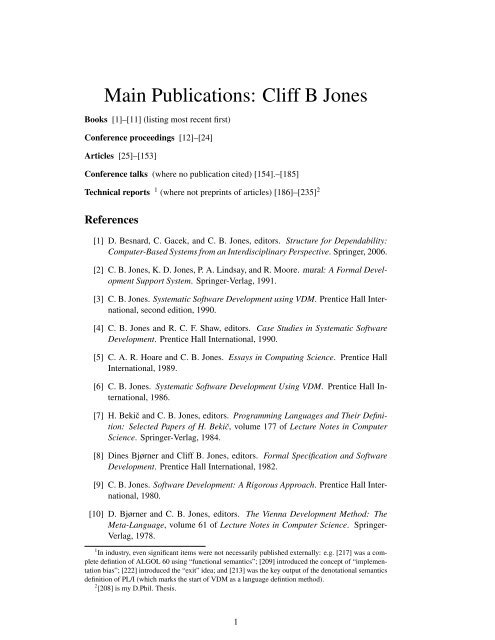

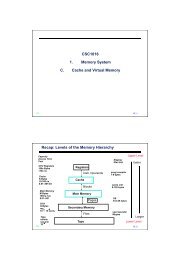
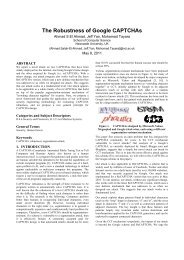
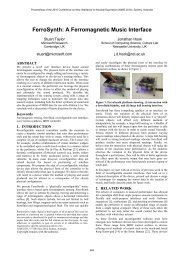
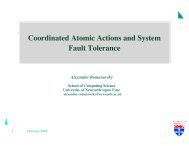
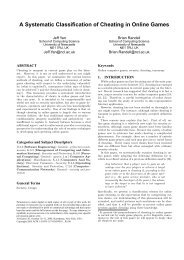
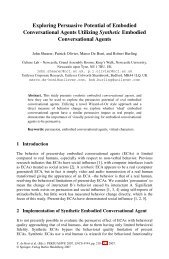
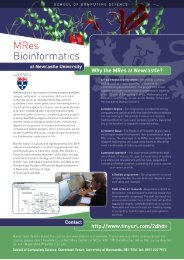
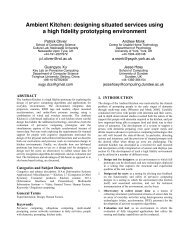


![Manuel Mazzara Full CV (November 2011) [PDF] - Computing ...](https://img.yumpu.com/33775457/1/184x260/manuel-mazzara-full-cv-november-2011-pdf-computing-.jpg?quality=85)
